Activity
Dice Probability
Analyze this simple betting game with your math student. Discuss probability - the measure of how likely it is an event will occur - as you work to figure out whether the odds of successfully rolling the 3 numbres during the three rounds of play are in the player's favor. All you need is a set of three dice, and you can get rolling! Play several times and look for patterns in the game. Is the player likely to win? Take a close-up look at each round of the game.
What You Need:
- Three dice
What You Do:
- Select a dealer and a player. The object of the game is for the player to roll a 1, a 2, and a 3 during 3 rounds of rolling the dice.
- If one of these numbers is rolled after the first or second round, they should put that die aside and not roll it again.
- If the player succeeds in rolling a 1, 2, and 3, they win.
- Switch roles and play again.
- After playing several times, start a discussion about probability. Ask: What are the chances of rolling a particular number in each of the three rounds? Is the game fair? Who has the better odds, the dealer or the player?
More About Probability:
If you're interested in the logic behind the odds, or probability, of rolling the right numbers, read on.
- First, figure out the odds of rolling just a 3. You have at least five chances of rolling a 3. How did you come up with five, you ask? Well, you might roll a 1 and a 2 in the first round, limiting your dice for the subsequent rounds to 1. So, you could roll 3 dice in the first round, 1 die in the second round, and 1 die in the third round. With at least 5 chances to roll a 3, the odds look pretty good. Now, let's look at all three numbers...
- In the first round, it's very likely you'll roll a 1, 2, or 3. Why? Because 1, 2 and 3 make up half of the total numbers on a die. Multiply 1/2 by 3 (because there are 3 dice), and chances are you will roll 1 1/2 of those numbers. (I know what you're thinking: Wait! You can't roll 1/2 of a number! Well, you're right. However, what these odds mean is you are likely to roll at least 1 of your numbers, and half the time you should roll 2 of them. This averages out to 1 1/2.)
- In the second round, the odds get a little bit tricky. Let's say you rolled just one of your numbers in the first round. This means, you have 2 dice to roll and 2 numbers to find. The odds of finding one of those remaining numbers is 1/3 (or 2/6). It is unlikely you will find either of your numbers in this round, but there is a chance. If you do find one of your numbers, you've just lowered your chances of finding the last number in the last round, with one dice, to 1/6. That is very unlikely.
- Let's consider another possible scenario: what if you rolled two of your numbers in the first round? (After all, that will probably happen 1/2 the time.) You would have 1 dice to roll and one number to find. Your odds are pretty low, as you now have a 1/6 chance in rolling that number. Keep in mind that you do get another roll in the third round, but you'll still only have a 2/6 (or 1/3) chance of rolling your desired number
- The odds do look pretty good at first, right? Nonetheless, as you progress through the rounds, you'll realize the odds aren't in your favor. Considering the probability, it's probably not a good idea to bet money on this game!
Related learning resources

Probability Practice
Worksheet
Probability Practice
Get some practice with probability! With this exercise, your child will practice using fractions to express probability of different outcomes.
4th Grade
Math
Worksheet
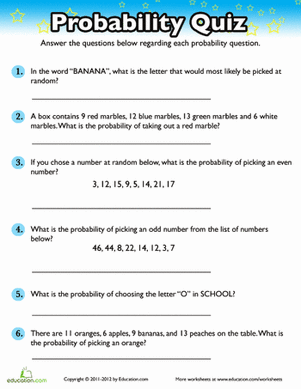
Probability Quiz
Worksheet
Probability Quiz
Here's a great opportunity for your child to practice probability! He'll solve word problems about the probability of choosing an item from a group.
4th Grade
Math
Worksheet
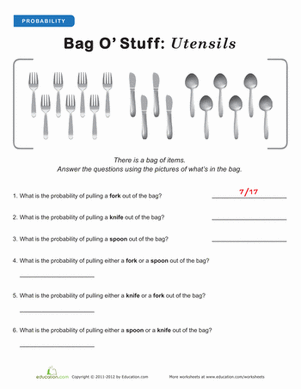
Intro to Probability: Utensils
Worksheet
Intro to Probability: Utensils
Serve yourself some knowledge with this probability worksheet! This great page will introduce your child to probability concepts.
4th Grade
Math
Worksheet
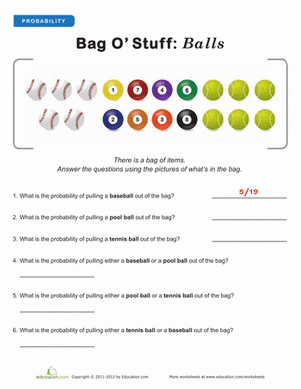
Introduction to Probability
Worksheet
Introduction to Probability
Introduce your child to probability concepts with this worksheet.
4th Grade
Math
Worksheet
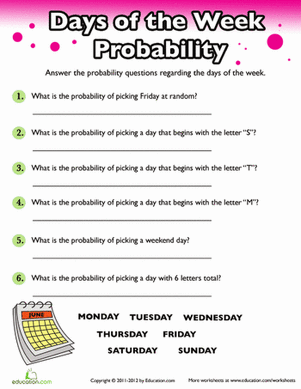
Probability: Days of the Week
Worksheet
Probability: Days of the Week
Practice probability with the days of the week! Your child will learn to find the probability of picking a random day on the calendar.
4th Grade
Math
Worksheet
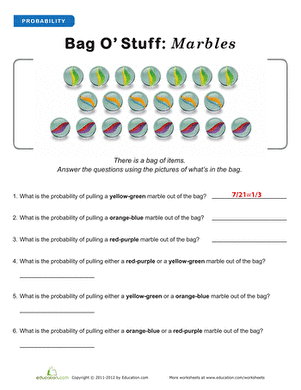
Intro to Probability: Marbles
Worksheet
Intro to Probability: Marbles
Introduce your students to probability concepts and fractions with a helpful and familiar visual aide.
4th Grade
Math
Worksheet
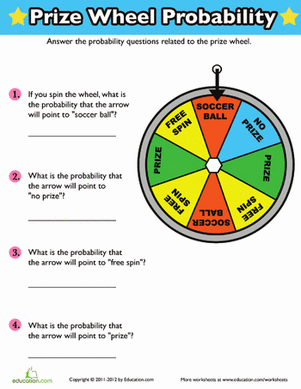
Probability Prize Wheel
Worksheet
Probability Prize Wheel
Give your child some practice with probability! With this exercise, he'll determine how likely each outcome of the prize wheel is.
4th Grade
Math
Worksheet
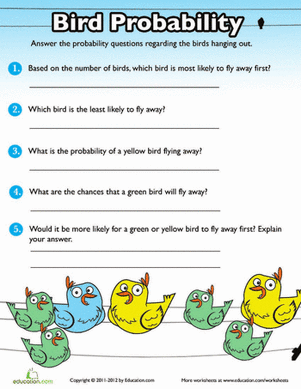
Probability Practice: Birds
Worksheet
Probability Practice: Birds
Practice probability and fractions with some feathery friends! In this exercise, your child will determine the likelihood of certain birds flying away.
4th Grade
Math
Worksheet

Probability Practice: Fish
Worksheet
Probability Practice: Fish
Help your child master the concept of probability with this fun, visual exercise!
4th Grade
Math
Worksheet

Probability Practice: Worms
Worksheet
Probability Practice: Worms
Have your child practice determining probability with a fun, visual exercise.
4th Grade
Math
Worksheet

Probability Grab Bag
Worksheet
Probability Grab Bag
With this worksheet, your child will practice determining probability with the grab bag.
4th Grade
Math
Worksheet

Intro to Probability: Playing Cards
Worksheet
Intro to Probability: Playing Cards
We don't condone gambling, but here's a fun worksheet to learn probability with playing cards.
4th Grade
Math
Worksheet
See this activity in a set:
Practice Makes Probability Perfect! Activities for Fourth Graders



